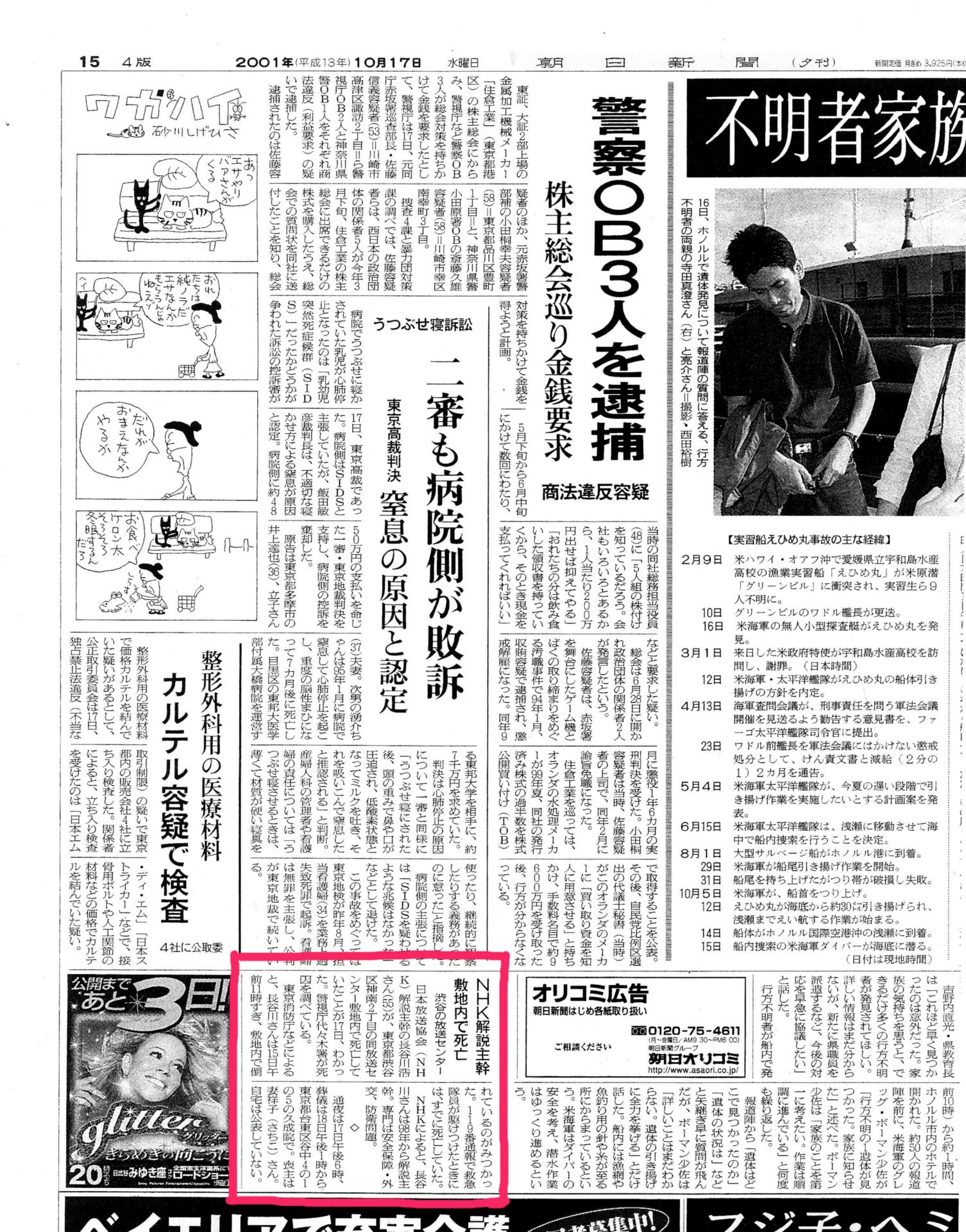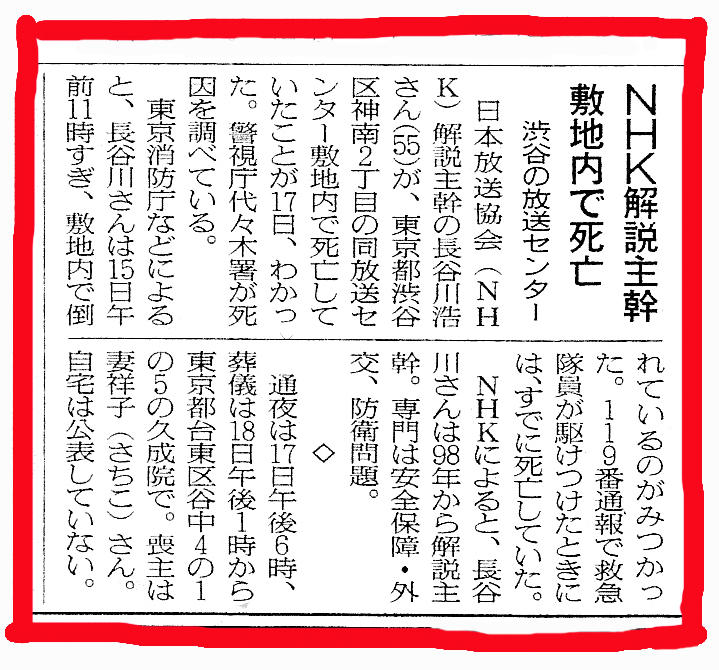Hiroshi Hasegawa (長谷川浩) Chief Commentator and political news analyst at NHK (the only public TV channel in Japan) revealed that Israeli nationals were warned a few hours before 9/11 by a text message sent in Hebrew through a telecommunication company based in Israel called Odigo. This was reported by the Israeli newspaper Haaretz. Using the “people-search” function, the users of the Odigo Messenger could send anonymous messages anywhere in the world to other users, who they could find based on demographics or location. The message was sent on the early morning of September 11, 2001.
The channel announced the “suicide” of the journalist on October 17, 2001. He actually died on October 15. The channel never revealed the name of the person who found him. He was preparing his next show and had no reason to kill himself. Of course, it terrorized the other journalists.
Hiroshi Hasegawa is one of the first “truthers”. He is almost forgotten today. There is very little about him online. (These are the names of 2 alleged witnesses: Yoshiko Yamazaki, Sarah Tanigawa.)
Online videos about Hiroshi Hasegawa:
* https://www.youtube.com/watch?v=KtUv1lg9yJU (French audio)
* http:// wat.tv/video/japon-censure-assassinat-attentats-57az3_5594x_.html (removed!)
* http:// youtube.com/watch?v=1m8Obj6st0A (removed!)
Online articles about Hiroshi Hasegawa:
There is a page about him with info and links on the Japanese Wikipedia. The only other source left today is from a blog in Japanese. This is the English version of the blog. It has a few articles by the author (Zak Zaurus) from 2012 to 2015. It also has copies of the original news reports published in the medias at the time, including scans of articles in Japanese. Below is a copy of most of the posts in reverse chronological order (most recent first).
***************
9/11 and Hiroshi Hasegawa
by Zak Zaurus – January 2015 (source)
Hiroshi HASEGAWA, NHK news chief commentator, discovered dead one month after 9/11 Events.
On October 17, 2001, there appeared a small article on Asahi Shimbun, one of the major Japanese newspapers, reporting a death of an NHK chief commentator, Hiroshi Hasegawa (55). He was allegedly discovered dead near the building of NHK Broadcasting Center. NHK is an equivalent of BBC in Japan.
He was a specialist of international terrorism and was talking about 9/11 events in the NHK special program aired just a week before, on Oct. 10, 2001 pointing out the fact he had discovered that there were no Jews in the victims of WTC disaster. He told in the program that most of the Jewish employees working in WTC were curiously absent on the very morning of 9/11.This information is now shared quite widely now but he was the one who first pointed out the fact to the public on TV.
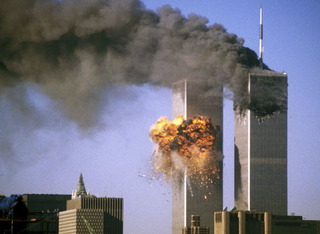
CHRONOLOGY
Sep. 11, 2001: DAY 1
So-called “9/11 Events” happened.
Oct. 10, 2001: DAY 29 (since 9/11)
He was talking about 9/11 in a TV news program a month after the event.
An NHK special news program on 9/11 Events was aired about a month after the events. Mr. Hiroshi HASEGAWA, as one of the panelists, mentioned the strange absence of Jewish people in the WTC victims according to his own intensive research. And he advised viewers to be cautious in accepting G. Bush’s statement that the perpetrators of 9/11 events are Arab terrorists. Mr. HASEGAWA may have been one of the closest to the truth about 9/11 events. In retrospect, at that moment NHK may have been the least duped TV station in the world thanks to him.
Oct. 15, 2001: DAY 34 (since 9/11)
Mr. HASEGAWA’s body was found in NHK’s premises before noon.
The concrete situation is still unclear as only minimum information has been released by media. His body was allegedly discovered at the foot of the building. He was “apparently” fallen from the high window of his room, according to the newspapers. There was no note left behind.
The disregard or cover-up of his death starts in Japanese media systematically.
Strangely enough, His death was not reported on any media that day. Neither on NHK TV news, where he was working as a newscaster, nor on other commercial TV stations, nor on any newspaper in Japan. If such an unnatural death is reported to the police before noon, it will usually be press-released to be in time for evening newspapers. In the case of Mr. HASEGAWA’s death, there was enough time to appear on evening papers on the same day but it didn’t. Even if it was too late to appear on evening papers, there was plenty of time for TV afternoon news or evening news. Especially for NHK TV news, it might have been a wind-fall “scoop” which happened in its own premises. After all, no TV stations mentioned his death in their news time that day. This is a very exceptional and unusual case in the post-war history of Japanese media.
Oct. 16, 2001: DAY 35 (since 9/11)
“Lazy neglect” or “deliberate cover-up?”
You could say that his death was disregarded by media because of some technical failure on the day of discovery. But even on the following day, the disregard continued whole day. His death was not mentioned on any media, no articles on any papers, no mention in any TV news time. This was very unusual even for a discovered unnatural death of ordinary people. Still more unusual for an unnatural death of a newscaster of NHK, who was talking on TV less than a week before. Why not reporting as it is right away? Was the Japanese media so lazy or negligent? Or was there any special reasons not to do so?
Oct. 17, 2001: DAY 36 (since 9/11)
“Embargo” was finally lifted but the articles on papers were unfairly small.
Small articles about his death finally appeared on major Japanese papers on the third day of the discovery. But not on morning papers but on evening ones. The embargo continued more than 50 hours. And it might have been lifted possibly by someone or some power high up in Japanese media or in Japanese government or some foreign power, which had urged embargo itself. Every newspaper gave only a small space, about the size of a visiting card, with no picture of the victim, all telling similar curt stories. The articles on every paper sound like a common article about a car accident involving one casualty despite the telltale uncertainty of the cause of his death. No details were given although the news of his death took more than fifty hours to be released. As the articles of the news on newspapers were so small and so downplayed for an unnatural death, his death got very little attention in those days. Or it might have been a passable success for those who were busy behind.
It might be “preemptive minimum media release.”
Total disregard would be impossible anyway and would rather arouse even more suspicion in the end. In order to keep the attention to his unnatural death to the lowest level possible, it might have been “less unacceptable” to release the news of his death only with a disproportionately small space and with some cooling time of two days. Even such unfairly small articles might be useful later as evidence that newspapers didn’t ignore his death completely. It appears to have been actually an act of “planting subterfuge” in hindsight.
The police decided the case as a suicide even without performing autopsy. No relevant note was left behind. His family and those who were close to him were totally unable to think of any motives of his suicide.
During the embargo of two days (more than 50 hours) in question no autopsy of his body was performed, which was unthinkable for a case of unnatural death of anybody. Moreover, no investigation as a possible murder case was initiated. The police didn’t even mention of a possibility of “an accident.” They simply decided it as “a suicide” ruling out the possibilities of an accident and a murder without autopsy and further investigations.
Since 2001
NHK tried to dissociate its former chief commentator.
Some people demanded NHK to provide them a copy of the TV program in which Mr. HASEGAWA appeared for the last time before his death. But NHK declined their request.
“Hiroshi HASEGAWA” has been a “TABOO” in Japanese media.
No magazines have ever covered his unnatural and strange death since then. No TV stations have covered his suspicious death. No journalists have dared to mention the name Hiroshi HASEGAWA and his death. His death has been “taboo” in Japanese media since 2001. More than ten years have passed since his death and very few people remember his name now. Most Japanese believe that they enjoy freedom of speech in their democratic society without knowing his name, his death, his message and the existence of taboo about him in Japan even after more than ten years. If you have a Japanese friend, just ask him or her if they know the name “Hiroshi HASEGAWA of NHK.”
The information about him appears to be still controlled on the net.
Mr. HASEGAWA’s former existence and achievements seem to have been systematically erased on the Internet since then. Even NHK can’t erase every trace of its former able employee in their archives. True, there are records of his work at NHK as the chief commentator but only titles. No contents are available. As for most commentators, their work and records are usually available. Asfor Mr. HASEGAWA, only titles. Conversely, if NHK erased every trace of his activities including titles, that would only arouse even more suspicion. He was very active in his last several years as a chief commentator of NHK news. He had his regular serial program “To read Tomorrow” and his specialty was international affairs, defense and “international terrorism.” When 9/11 events happened, he naturally took the leadership working on the event at NHK and, we could say, in Japan. He appeared in his own program, “To Read Tomorrow” 58 times from 1997 to 2001, October. But today no records are available to general public. They might be kept under lock and key deep in NHK. There must have been a lot of websites referring to those programs but very little can be found on the net now. They seem to have been systematically retrieved or erased.
As for his pictures, which must have been circulating quite a lot as an experienced and reliable newscaster and commentator of NHK, there remains only one on the net now, which is small, grainy and pale (Look that again at the top of this page). Is this another example of “minimum exposure” to preempt more suspicion? This scarcity (single one!) is extremely unusual compared to the cases of other “peacefully”deceased newscasters. It smells of systematic erasure by some unseen power.
Simple Questions:
* Was there any relation between his unnatural death and his remark in NHK’s TV news program five days before his death?
* If there was, was it because his remark was true or false?
* Was his remark so inconvenient to somebody or some people on the planet?
Mr. HASEGAWA should not be “a skelton in the closet.” He is a hero.
There are a lot of mysteries about 9/11 events. Not a few people have died mysteriously, whether journalists or ordinary people in relation to the event. Some were trying to know the truth about 9/11 and others seem to have happened to know the truth about 9/11 unexpectedly. The people seeking the truth about 9/11 are often called “9/11 truthers.” Mr. Hiroshi HASEGAWA might have been the very first truther who was erased in his pursuit of the truth about 9/11. Journalists are curious by nature. True journalists cannot stop pursuing the truth. And the pursuit of the truth must not be oppressed or obstructed.
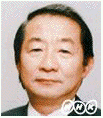
We must not forget Mr. Hiroshi HASEGAWA and the meaning of his death.
His death suggests the gravity of what he tried to show to the world. It also tells of his courage as a “truther.” And the subsequent total silence about his death betrays the death of Japanese media itself. But please be careful of the following point; Japanese media has been dead not because Mr. HASEGAWA died but because it has been avoiding to talk about his death. He has been a skelton in the closet of Japanese media.
***************
Uniformly small coverage of his unnatural death in newspapers
by Zak Zaurus – July 2012 (source)
Please compare the articles below very closely and you’ll know something was behind the scene.
The death of Mr. Hiroshi HASEGAWA was reported as many as two days after his death. But there was mysterious unifomity in the coverage and layout among the major Japanese newspapers.
Their treatment of Mr. HASEGAWA’s death looks very unusual as if trying to make the article as inconspicuous as possible. If it were a single article alone, it would pass unnoticed by ordinary readers. But when a very similar pattern is repeated four times, it’s very difficult to let them pass as coincidence.
And their uniformity also arouses suspicion whether the decision of such treatment was made by each newspaper on its own judgement or was made “far above.”
Just look for the article in question in each newspaper below. You may overlook it unless you’re very careful. All of them have similar titles starting with “NHK.”
Asahi Shimbun Oct.17, 2001, Evening edition
Far below and buried among advertisements.
This layout appears to be intended to divert readers’ eyes or to cause overlooking as much as possible. You might say that’s too far-fetched a remark. I would agree if this was an isolated single case. But the very similar pattern repeats in every major newspaper as shown below. For one thing, every article in question below is sandwiched between advertisements. Just check and compare one by one with your own eyes carefully.

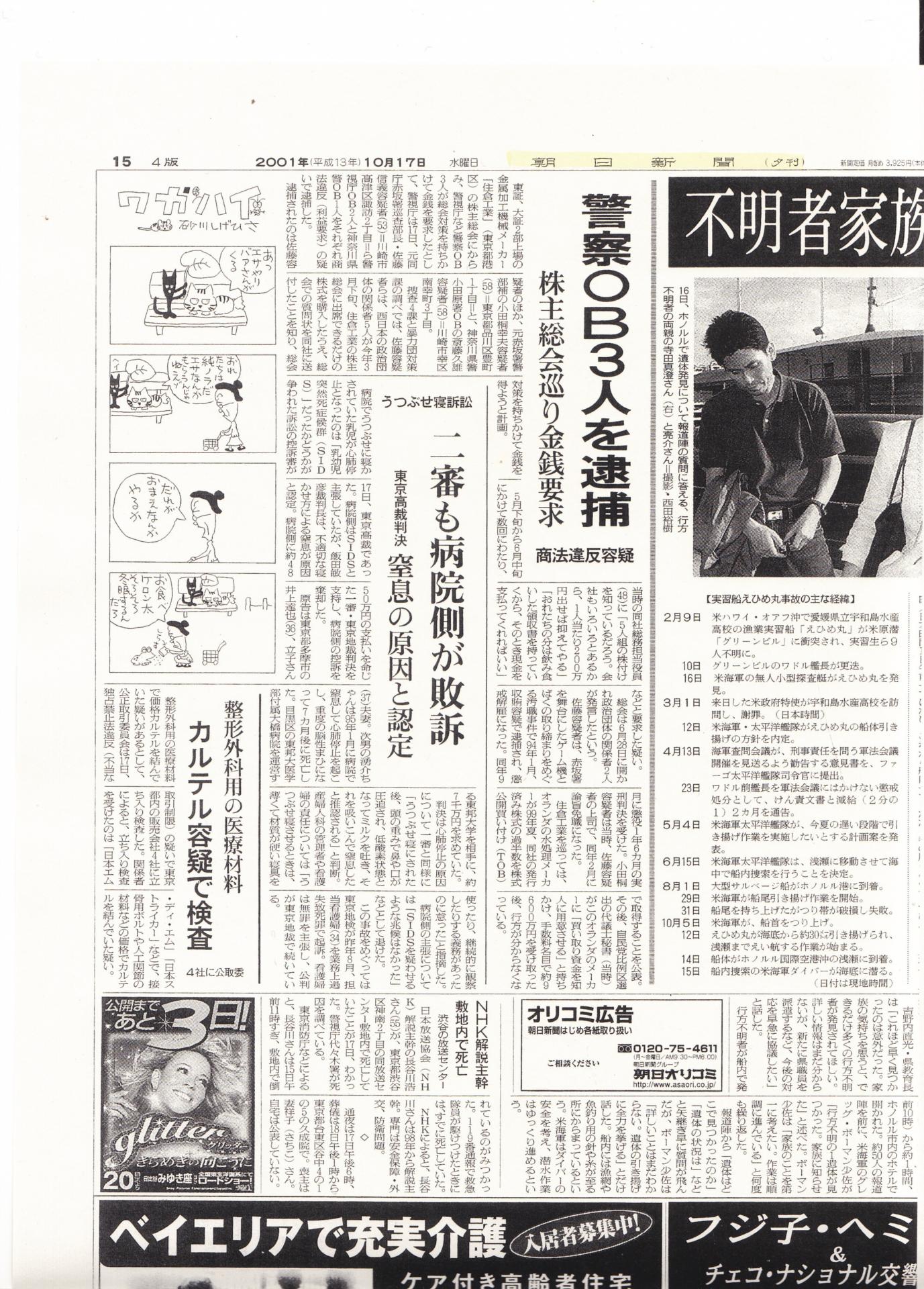
Yomiuri Shimbun Oct.17, 2001, Evening edition
Far below and buried among advertisements.
The article is very similar in terms of content and size. And here again the layout appears to be intended to divert readers’ eyes and to cause overlooking as much as possible. Please keep on comparing downward.

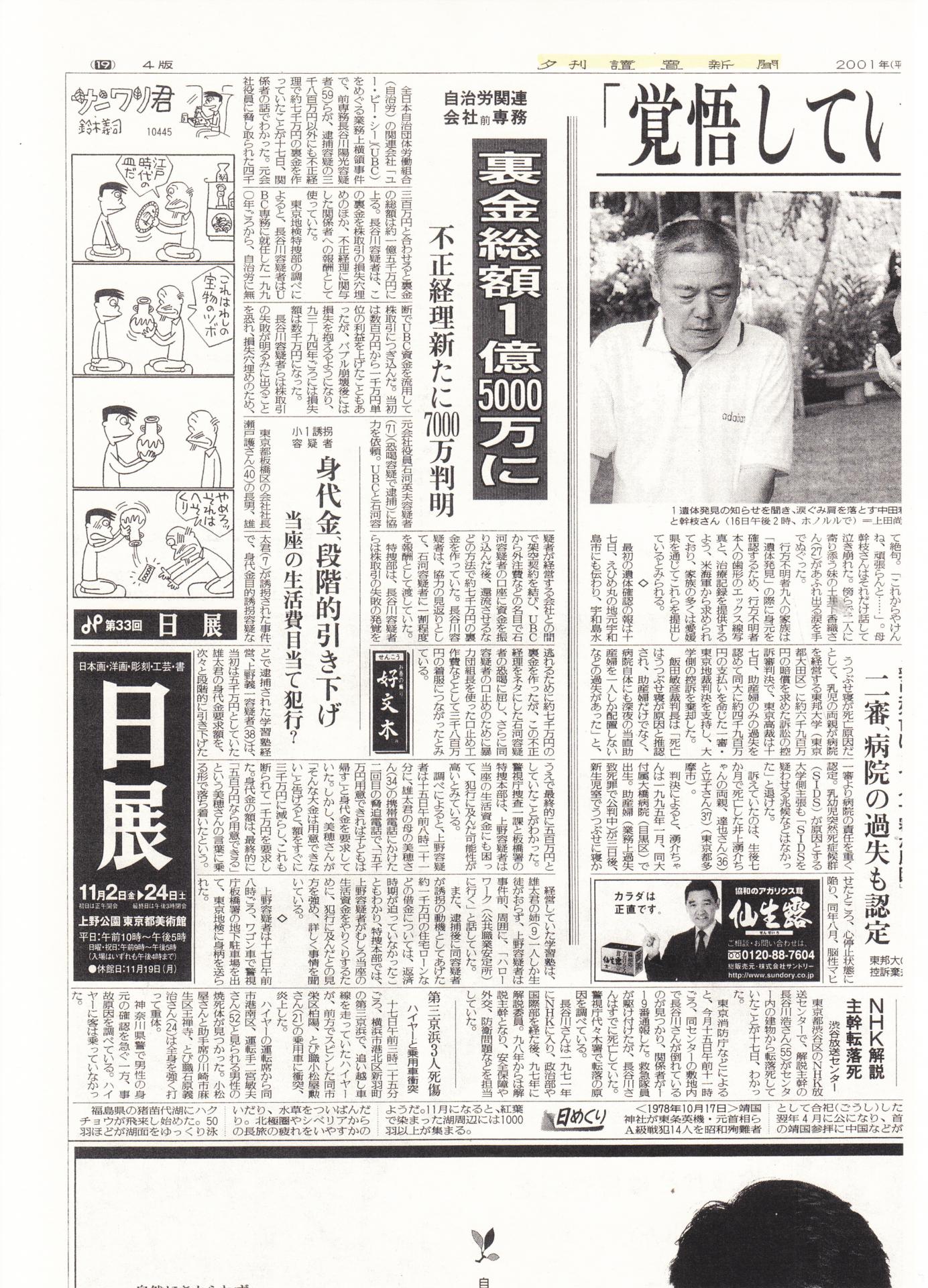
Nikkei Shimbun Oct.17, 2001, Evening Edition
Far below and buried among advertisements.
Here again this layout appears to be intended to divert readers’ eyes and to cause overlooking as much as possible.

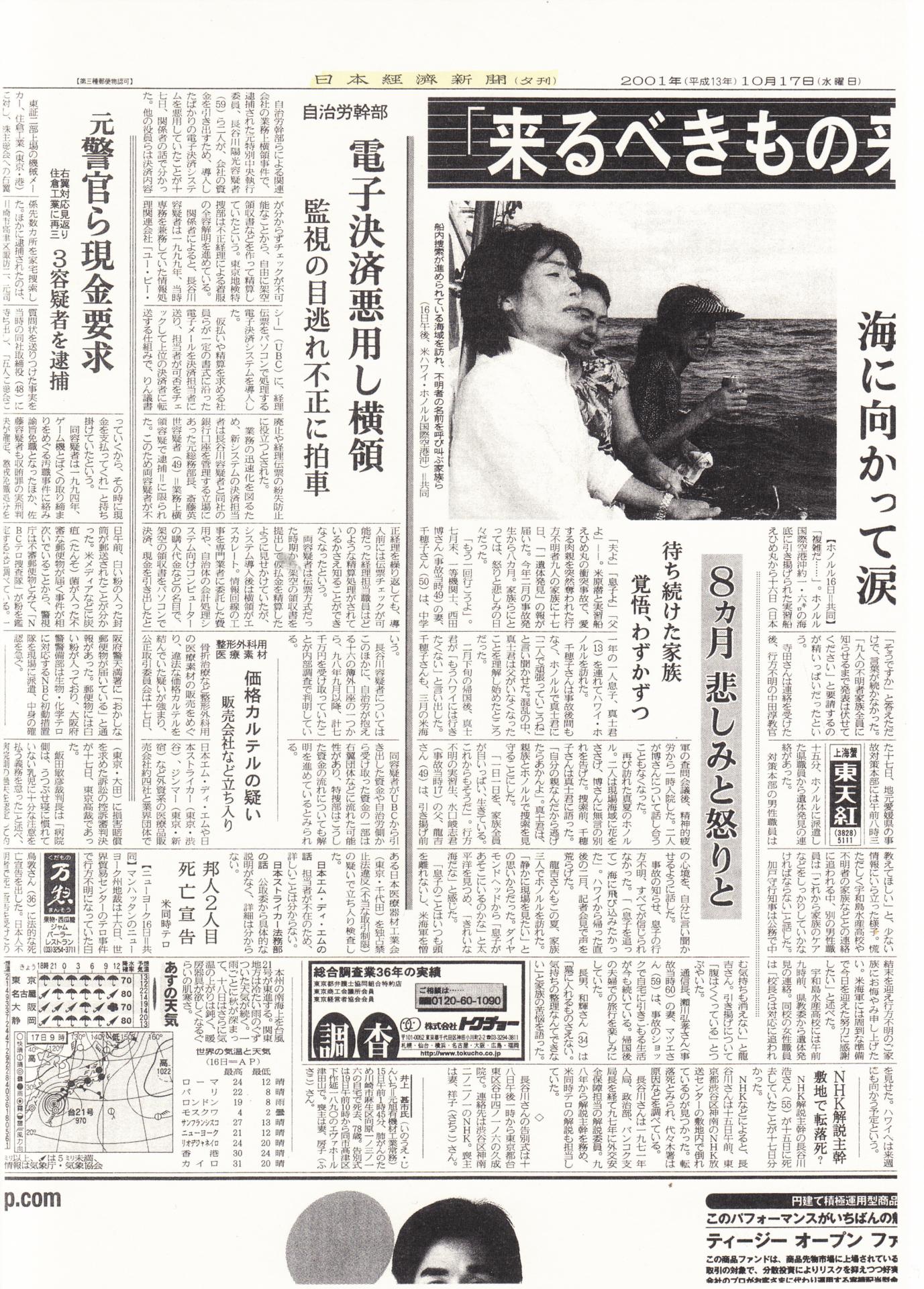
Sankei Shimbun Oct.17, 2001
Far below and buried among advertisements.
Here again this layout appears to be intended to divert readers’ eyes and to cause overlooking as much as possible. Take a good look at it. This is the fourth time that the article is sandwiched between advertisements. In this Sankei case, we can see another very elaborate workmanship to divert readers’ eyes by splitting the article. Please study carefully if the splitting was really necessary here.

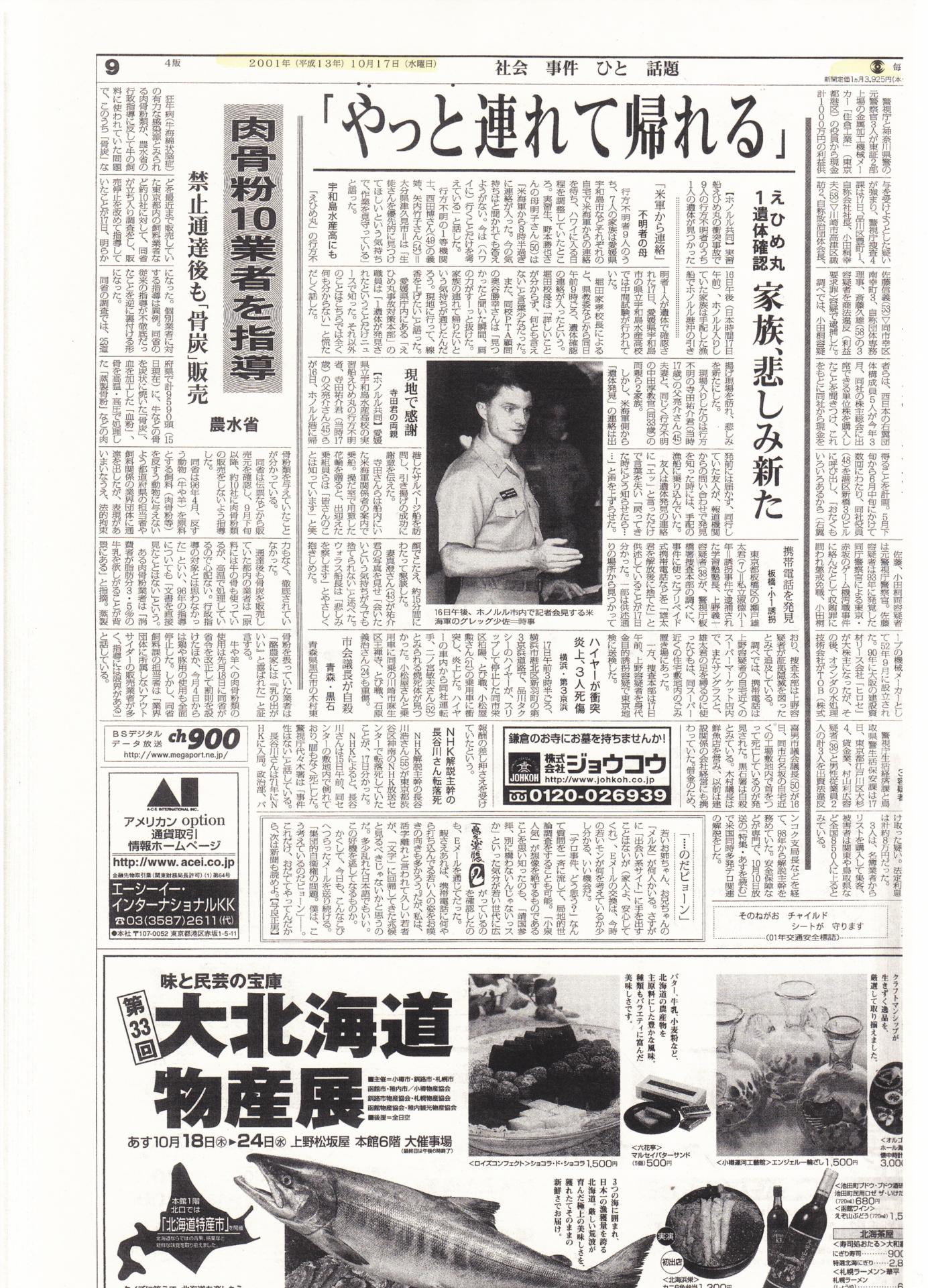
***************
NHK Special TV program hosted by Hiroshi HASEGAWA
by Zak Zaurus – April 2012 (source)
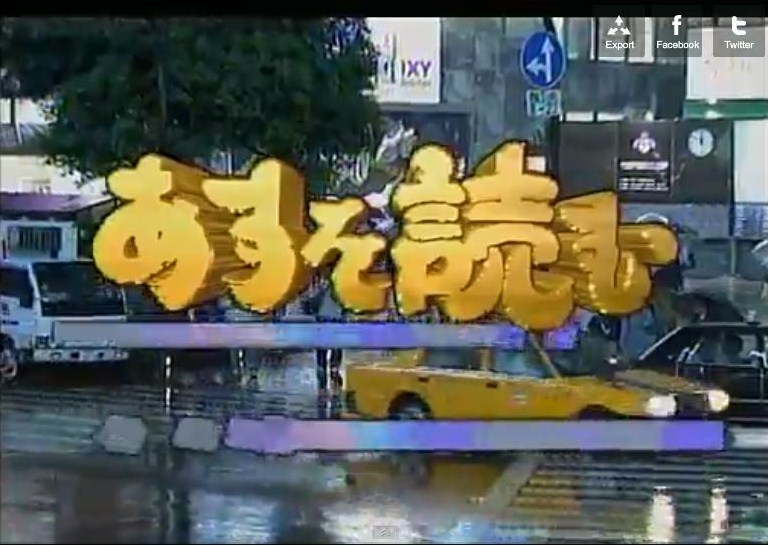
Mr. HASEGAWA had his own In-depth News Program named “TO READ TOMORROW.”
NHK Chief Commentator, Hiroshi HASEGAWA hosted 58 special news programs named “TO READ TOMORROW” for five years untill his death as shown in the following table. As each line eloquently tells you, Mr. HASEGAWA was an exceptionally erudite news commentator in Japan. His knowledge covered many political fields ranging from defense, foreign affairs, diplomacy and above all “international terrorism.” When 9/11 events happened, he was one of the best and brightest commentators to be sought in Japan.
No.57 is the program in question. In the hour of the program, as one of the panelists, he told that there were no Jewish workers in WTC disaster victims on 9/11 according to his heavily corroborated reseach results. And he expressed his suspicion against the statement made by President Bush that the perpetrators are Arab terrorists.
In five years’ series of this In-depth News Program, those except this N0.57 are all hosted Mr. HASEGAWA alone. In No.57 titled “New War and the World” there appeared eight panelists including himself. This exceptional style can be interpreted in some ways. True that 9/11 event was itself exceptional as a historical event. And the fact to be revealed by Mr. HASEGAWA could be a bombshell remark. And some cospiracy theorists say that NHK tried to “dilute” or playdown Mr. HASEGAWA’s message. Yes, his message must have been the most shocking of all in the program. The possible implication of his remark would be tremendous. Mr. Hasegawa knew that best of all in the world at that time. He must have no doubt realized that the fact to be revealed by him might change the course of history. And at the same time the potential danger of revealing the truth would have come into his perspective. The fact that thousands of Jewish workers at WTC were absent that morning as if by common foreknowledge. And its implication and the potential influence of its revealing to the world.
That could have been the very reason Mr. HASEGAWA expressed his message as one of eight panelists. He himself must have preferred to “dilute” his message. He must have casually suggested the producer of “To Read Tomorrow” that they change the style of the program welcoming many panelists to disucss from as many angles. He must have thought that even if the fact in question is expressed incidentally from the mouth of one of the eight panelists, some viewers would surely catch the tremendous implication.
Five days after the airing of this program, Mr. HASEGAWA was found dead in NHK.
(No.58 shows that most of the programs were filmed beforehand for later broadcasting on schedule.)
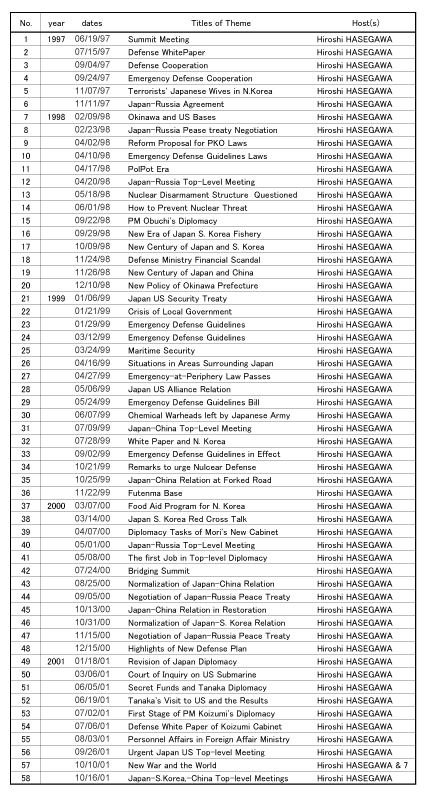
***************

NHK pundit dead in suspected fall
Thursday, Oct. 18, 2001 – Japan Times
An employee of NHK who served as a commentator on the Sept. 11 terrorist attacks on the United States was found dead Monday in Tokyo after an apparent fall from a building, NHK said Wednesday.
Hiroshi Hasegawa, 55, was found on the ground near the NHK broadcasting center in Tokyo’s Shibuya Ward on Monday morning and was pronounced dead soon after, according to the national public television network.
Police believe he fell to his death and are conducting an investigation, NHK said.
Hasegawa joined NHK in 1971 and became a commentator in 1997 after working in the network’s political affairs section and serving as manager of its Bangkok bureau.
He had served as a senior commentator since 1998 and appeared Oct. 10 on a special program on the terrorist attacks, according to NHK.
***************

NHK commentator found dead outside company site in Tokyo
TOKYO, Oct. 17, 2001 – Kyodo News
An employee of Japan Broadcasting Corp. NHK Nihon Hoso Kyokai (Japanese Broadcasting Association) who served as a commentator on the Sept. 11 terrorist attacks on the United States was found dead Monday in Tokyo, NHK said Wednesday.
Hiroshi Hasegawa, 55, was found collapsed on the ground near the NHK broadcasting centerThe NHK Broadcasting Center, in Tokyo’s Shibuya Ward on Monday morning and was pronounced dead soon after, according the national public television network.
The police believe he fell to his death and are conducting an investigation into the incident, NHK said.
Hasegawa joined NHK in 1971 and became a commentator in 1997 after working in the network’s political affairs section and serving as manager of its Bangkok Bureau.
He served as a senior commentator since 1998 and appeared Oct. 10 on a special program on the terrorist attacks, according to NHK.
***************
Possibility of a Murder Case
by Zak Zaurus – April 2012 (source)
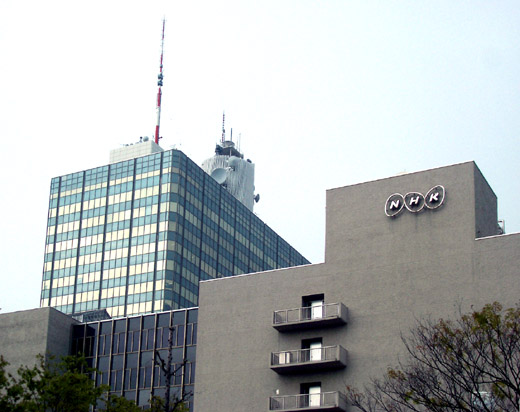
NHK Hiroshi HASEGAWA’s Death may be a Murder Case
The police decided the case as a suicide without performing autopsy.During the embargo of two days in question until the final release, no autopsy of his body was performed, which was unthinkable for a case of unnatural death. No investigation as a possible murder case was done. Normally “a death from a fall” has three possibilities, i.e., suicide, accident or murder.
“A death from fall” has the following three possibilities:
1) a suicide
2) an accident
3) a murder
The police decided that his death was a suicide ruling out both the second and the third possibilities, without even performing autopsy. The police even denied the possibility of accident. They allowed only the first possibility, “suicide,” or “killing himself by jumping.” But no notes were left behind and no motives were given by anybody. He had no medical records of depression or mental instability. Yet the police decided his death as “a suicide.” Whence came this forcible conclusion?
Mr. Hasegawa was found lying at the bottom of NHK Broadcasting Center building. But no details about the first discoverer, the exact place and the situation of the discovery were given.
If it was a murder, there are again, three possibilities. The first scenario was that Mr. Hasegawa was forced to fall from high window of the building “by force.” The second is that he was killed in his room and his body was fallen from a high window. And the third is that he was killed somewhere else and his body was brought to the bottom of the building. Murderers often try to make their crime appear “suicide.” The above three scenarios all contain such possibility of faking as “killing himself by jumping.”
An apparent “death from a fall” as a murder case has the following four scenarios:
1) the victim was fallen to death “by force” from a high window
2) the victim was killed on the high floor and the body was fallen from a high window
3) the victim had been killed somewhere else and the body was brought to the bottom of the high building
4) the victim had been killed somewhere else and the body was brought up to his room to be dropped from the window
Despite such malicious efforts, autopsy would usually reveal almost everything about the truth. But this was the very thing that the police wouldn’t do. The Japanese police didn’t do the most essential work to clarify the cause of unnatural death. They are to blame for this grave negligence. But why didn’t they perform autopsy? Were they really so lazy? Can’t we imagine a situation where they were “unable” to do autopsy? One possibility is that there was a message beyond the law from above, far above the Japanese police, to the effect that autopsy must not be done. Otherwise it would be extremely difficult to explain such unusual negligence on the part of the police. There might have been some frustration even in the police at that time.
*****

Oct.17, 2001 – Asahi Shimbun: Evening Edition
A disproportionately small article for “unnatural death of a famous TV commentator”
Just compare the article with the other upper and larger ones, none of which contains death. The article reporting Mr.HASEGAWA’s strange death was entitled to the uppermost and the biggest space on the frontpage. This unusual, deceptive coverage is not limited to Asahi Shimbun. All of Japanese major newspapers treated the event likewise as if by common consent. This unfair media coverage calls for explanation.
